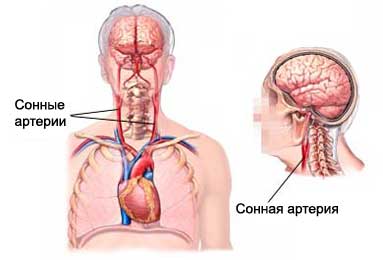Carotid endarterectomy – Carotid endarterectomy
Description of carotid endarterectomy
The carotid artery supplies blood to the brain through the neck. Blocking this artery can lead to brain damage – stroke.
Carotid endarterectomy – surgery to remove the precipitate carotid. The precipitates in the form of plaques can slow down and even stop blood flow therethrough.

Reasons for carotid endarterectomy
This procedure helps to restore proper blood flow to the brain, that helps prevent stroke and transient ischemic attacks (TIA). TIAs are considered a sign of the coming of stroke.
Possible complications during carotid endarterectomy
Before, How to perform karotidnuju jendarterjektomiju you need to know about possible complications, which may include:
- Bleeding;
- Infection;
- Damage to the carotid artery;
- High blood pressure (hypertension) or low blood pressure (hypotension);
- Stroke;
- Nerve damage in the neck.
Factors, that may increase the risk of complications include:
- Smoking;
- The degree of blocking the carotid artery;
- Lock the carotid arteries on both sides of the neck;
- Diabetes.
How is carotid endarterectomy?
Before surgery
Your doctor may order tests:
- Blood and urine tests;
- Electrocardiogram – test, which detects heart activity by measurement of electrical current through the heart muscle;
- Arteriography – type of X-ray inspection, wherein the contrast agent is injected into an artery, to make them more visible in the picture;
- Ultrasonography – test, which uses sound waves to study the carotid arteries;
- Magnetic resonance angiography (MRA) – test, which uses magnetic waves, along with a contrast agent, to make pictures of arteries inside the body.
The patient may be asked to stop taking certain medicines a week before the procedure,:
- Aspirin or other anti-inflammatory drugs;
- Blood thinners, such as clopidogrel or warfarin.
The night before, you can eat a light meal. You can not eat or drink anything after midnight.
Anesthesia
You can use the following types of anesthesia:
- General anesthesia – during the operation the patient is asleep;
- Local anesthesia – It will anesthetize the area of surgery, the patient is awake.
Description of the procedure of carotid endarterectomy
The patient will lie on the operating table. Special cushion is placed under the arm, head turned to the side. Incision in the skin over the lateral surface of the neck – from ear to a point just above the sternum. Up and down the carotid artery clamps will be placed. In some cases, in order to maintain blood flow to the area of operation will be used temporary tube, which are removed after surgery.
The artery is opened and cleared of plaque. Then the artery is sewn. Clips (and bypass tubes, if used) deleted. The doctor may remove part of the carotid artery. In this case, the place of the remote segment is sewn artificial graft or a vein segment, taken from the other body part. The skin incision is sewn stitches.
Immediately after treatment
Your doctor may do arteriography. This is to ensure, to make sure, that in place of operation no complications, such as blood clots or narrowing. Patients may give medicine, helps prevent blood clotting.
How long will the CEA?
Duration of operation 2-4 o'clock.
Carotid endarterectomy – Will it hurt?
Anesthesia prevents pain during the procedure. After the procedure, the recovery period is assigned analgesic.
The average hospital stay
Typically, the duration of hospital stay was 1-3 day. The doctor can extend the course of treatment, If there are complications.
Patient care after carotid endarterectomy
Home Care
The average recovery time is two weeks. Upon returning home, you need to perform the following actions, to ensure the normal recovery:
- Neck to keep straight. At the time of recovery head on the bed should be kept on the dais;
- We need to take medication, as prescribed by your doctor. Anticoagulants help to prevent blood clots. Physician prescription and nonprescription pain relievers will help to cope with the discomfort;
- You can resume daily activities, when it becomes possible;
- You can not get behind the wheel for three weeks after surgery or until it will not allow the doctor;
- It is necessary to avoid intensive exercise for six weeks after surgery;
- Changes in diet can help prevent new plaque deposition. We need to stick to a diet low in saturated fat, consume more fruits, vegetables, cereals and fish;
- We need to ask your doctor about, when it is safe to shower, bathe, or to expose the surgical site to water;
- Be sure to follow your doctor's instructions.
Contact your doctor after carotid endarterectomy
After discharge from the hospital need to see a doctor, If the following symptoms:
- Signs of infection, including fever and chills;
- Redness, edema, increased pain, bleeding, or discharge from the incision;
- Nausea and / or vomiting, which do not disappear after taking the prescribed medicines, and persist for more than two days after discharge from the hospital;
- Pain, which does not pass after taking pain medication appointed;
- Severe headaches, swelling in the neck, or other symptoms;
- Cough, breathlessness, chest pain;
- Memory loss;
- Sagging facial muscles;
- Difficulty with speech, sight, or coordination;
- Weakness;
- Armache;
- Increased sweating;
- Dizziness and fainting.
